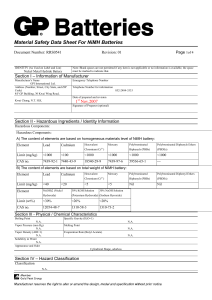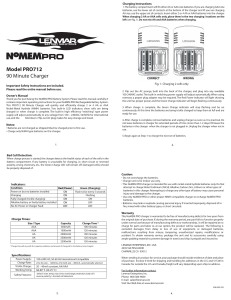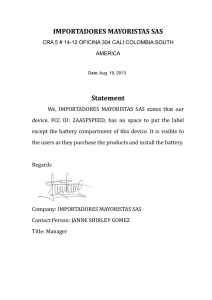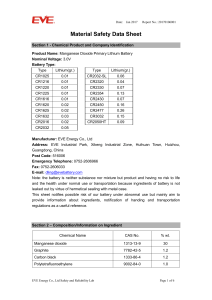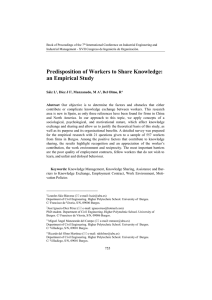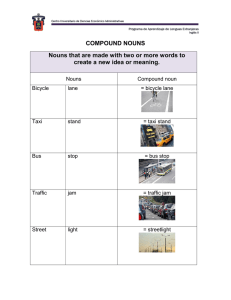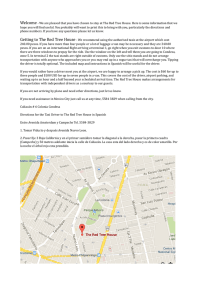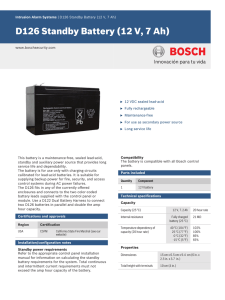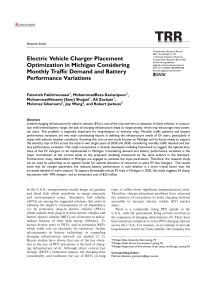An Electric Taxi Fleet Charging System Using Second Life
Anuncio
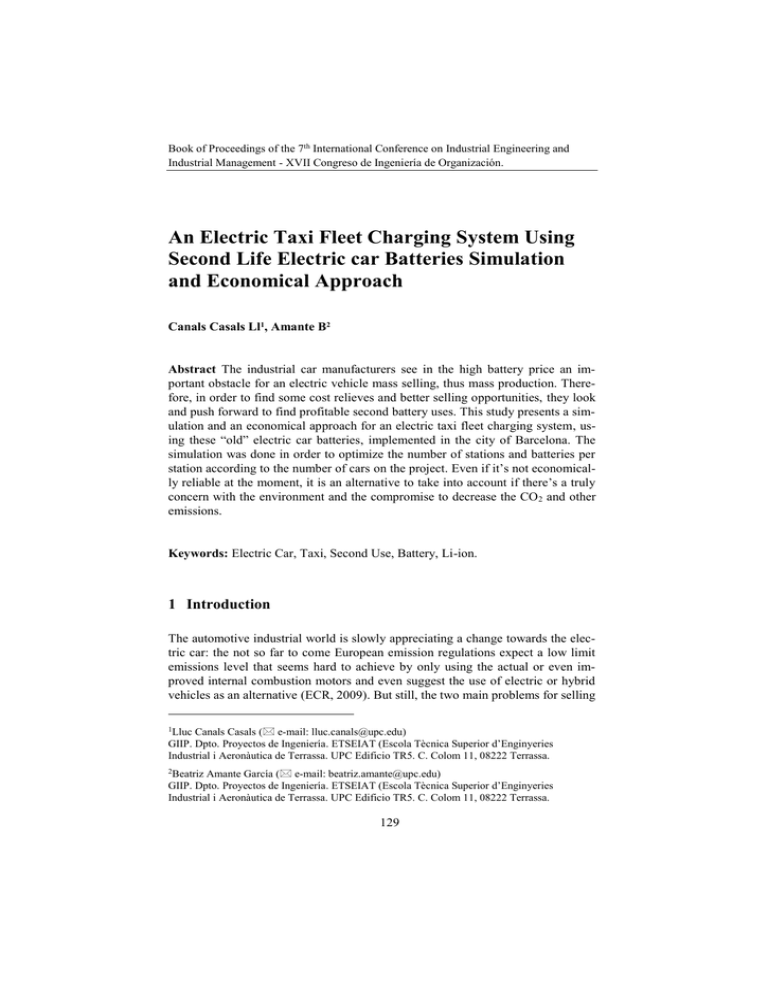
Book of Proceedings of the 7th International Conference on Industrial Engineering and Industrial Management - XVII Congreso de Ingeniería de Organización. An Electric Taxi Fleet Charging System Using Second Life Electric car Batteries Simulation and Economical Approach Canals Casals Ll1, Amante B2 Abstract The industrial car manufacturers see in the high battery price an important obstacle for an electric vehicle mass selling, thus mass production. Therefore, in order to find some cost relieves and better selling opportunities, they look and push forward to find profitable second battery uses. This study presents a simulation and an economical approach for an electric taxi fleet charging system, using these “old” electric car batteries, implemented in the city of Barcelona. The simulation was done in order to optimize the number of stations and batteries per station according to the number of cars on the project. Even if it’s not economically reliable at the moment, it is an alternative to take into account if there’s a truly concern with the environment and the compromise to decrease the CO 2 and other emissions. Keywords: Electric Car, Taxi, Second Use, Battery, Li-ion. 1 Introduction The automotive industrial world is slowly appreciating a change towards the electric car: the not so far to come European emission regulations expect a low limit emissions level that seems hard to achieve by only using the actual or even improved internal combustion motors and even suggest the use of electric or hybrid vehicles as an alternative (ECR, 2009). But still, the two main problems for selling 1Lluc Canals Casals ( e-mail: lluc.canals@upc.edu) GIIP. Dpto. Proyectos de Ingeniería. ETSEIAT (Escola Tècnica Superior d’Enginyeries Industrial i Aeronàutica de Terrassa. UPC Edificio TR5. C. Colom 11, 08222 Terrassa. 2Beatriz Amante García ( e-mail: beatriz.amante@upc.edu) GIIP. Dpto. Proyectos de Ingeniería. ETSEIAT (Escola Tècnica Superior d’Enginyeries Industrial i Aeronàutica de Terrassa. UPC Edificio TR5. C. Colom 11, 08222 Terrassa. 129 Book of Proceedings of the 7th International Conference on Industrial Engineering and Industrial Management - XVII Congreso de Ingeniería de Organización. these vehicles to most of population are the high price (mostly due to the battery costs) and the not so long displacement range (about 200km max.) (Broussely M, 2007). In order to solve the first one, the automotive industry is searching for second uses of the already used batteries trying to have some extra revenue and decrease the selling price (Kley F., 2011) , (Vilayanur et al, 2011). For the displacement range, fast 15 to 30 minutes charging stations are considered (Botsford C. et al, 2009), (Muñoa J.A. 2009) as first steps to permit longer drive trips. With this time, the batteries are charged until an 80% of SOC which is, by the way, the normal charge available for second use batteries (Kley F., 2011) . 2 Material and Methodology The idea of a charging system for an electric taxi fleet using recovered “old” batteries comes from unifying the two propositions in one project. The use of second life batteries reports a money income to the car manufacturer, which is a must considering the high prices from today (Broussely M, 2007) and the 15-30 minutes charge per taxi would permit the taxis to cover the whole day work medium range of a Barcelona Taxi service with just one charge during the day. It is considered that the medium km range per year of a Barcelona taxi is close to 42.000km (Amat C. 2010), (Zamora B. et al, 2012). That is, divided by 230 working days, 183km per day. It is close to the maximal range defined by some car manufacturers. For this simulation a 130km average range will be taken, considering that a 10-15% of security margin will be taken by the drivers before getting out of energy. That means that each car will surely have to stop once during working time and the next charge, in order to start the day with a full capacity, will be done at home while the car is parked and the driver sleeping in a slow charging mode. The use of second use batteries (“old batteries” from now on) for this system is thought because the normal fast charge stations presents enormous instant consumption, power and high voltage installations that might come with legislative and security impediments if implemented inside the city (Botsford C. et al, 2009). What is presented here is a system that charges at a low velocity rate, with a common 220V electricity installation, the “old batteries”. Then, when they are charged, its energy is trespassed to the ones in the vehicle in a fast charge mode. The interesting point is that this fast charge is done isolated from the grid, so no high power demand is necessary. The car batteries need a 6 to 8h charge (Botsford C. et al, 2009) on a slow charging mode, and so will do the “old” ones. If they need 6h charge, it means that almost four cars can be charged per day, on the contrary, if it’s close to 8h, that will correspond to 3 charged cars per day. This is important for the economic and 130 Book of Proceedings of the 7th International Conference on Industrial Engineering and Industrial Management - XVII Congreso de Ingeniería de Organización. volumetric issues, as more cars are charged per battery, less batteries have to be placed per station. As a fast charge takes over 30 minutes to conclude (see considerations below) if a free spot is desired to be freed every 15 minutes, a minimum of two charging spots per station should be installed. And as the second use batteries are supposed to need 6h to be ready to transfer its energy to the taxis, and one should be ready every 15 minutes, at least 24 batteries should be placed per station. In figure 1 there’s a schema of what it has been just told. The black lines represent taxis entering and leaving the charge station. The yellow ones represent the stages of the second use batteries. When they are ready they are shown as “entering” into the station with a taxi and they give their charge to the taxi in the 1 st or 2nd charging spot for over 30 minutes. When the cars are charged the second use batteries are discharged and they change to the 6h slow charge mode (which is represented as the second use battery 6h charge box) until they are ready again to restart the cycle. Charged Second use batteries Incoming taxi Charged Second use batteries Incoming taxi Taxi charging 1st spot. 30min Second use battery 6h charge Taxi charging 2nd spot. 30min Taxi goes back to work and home Fig. 1 Schema of a single 2 spot station. The simulation was done as described in figure 1 for a single 2 spot station. In order to eliminate queues, the taxi fleet should agree that each taxi should start working at a scheduled time (each hour, half an hour or per quarter of an hour). If all taxis start working at the same moment, the stations should be overdimensioned during most of the day in order to be able to have free spots when almost all cars come to charge. In all cases tested a whole week simulation was done in order to eliminate the first steps transitory effects. Although some analyses were done taking the 8h low charge rate, in this article only 6h will be discussed because it is considered that if it does not work economically in this way nor will it do with a lower charge rate (which is a worse optimized / optimistic model). 131 Book of Proceedings of the 7th International Conference on Industrial Engineering and Industrial Management - XVII Congreso de Ingeniería de Organización. Since beginning 2013 there’re no more working turns in Barcelona (taxibarcelona.cat, 2013), so the fleet can apply its own schedule in order to optimize the availability of charging spots and batteries. As it is impossible to apply a minute to minute schedule such as: a taxi will enter into work at exactly every 8 minutes, it is suggested (simulations were done so in this way) to establish a beginning to work timetable each every hour. A balance between cost and waiting time was done in the analysis. Considerations taken: 1. The average waiting time by taxis on the charging station for a free spot should not exceed the 10 minutes, 2. Almost no time was considered as allowable in waiting for a battery to be charged. Therefore, two extra second use batteries per station were added. It will also be useful in case of damaged or degradation of too aged batteries. 3. No more than an hour waiting for a free spot was acceptable as a positive result. 4. Cars entered into the simulation every hour with a 5 minutes standard deviation. 5. 6h with a 10 minutes deviation was considered as second use battery charge time. 6. 30 minutes discharge (or car charge). Even if in most of the cases the expected charging time would be less than 30 minutes (Botsford et al, 2009), some minutes were added because of the drivers needed time to disconnect and leave the spot free. 7. Because of the different driving characteristics (and electricity consumptions in consequence) a deviation of half an hour is added to the system to make a more realistic need to charge situation. 3 Results and Discussions The less expensive solution encountered taking the previous considerations into account was a 26 battery per 2 spots. The simulation result showed that each spot was capable of providing energy to an average of 42 cars per day. As the longest distance in Barcelona is from the airport to the other edge of the city and it is no more than 20 km, it is considered that a taxi will always be able to go to the next charging station without problems if the car gives an alarm when 15% of SOC is achieved (15% of 130km gives 19,5km). Note: If the stations have more than 2 spots, having less than 2 extra batteries per spot showed also good results. Anyhow, the extra cost of another battery per spot is of 24€/year per driver, so the money saved per year is not what makes de difference. 132 Book of Proceedings of the 7th International Conference on Industrial Engineering and Industrial Management - XVII Congreso de Ingeniería de Organización. With this disposal an 85% of the “theoretically” station capacity was used. Even so, as it can be appreciated in table 1, the queues attained an average of 9 minutes waiting for a free spot and a maximum waiting time of 57 minutes (almost an hour). To this waiting time it has to be added the 30 minutes charging, so the driver that took almost an hour and a half for refilling the battery will surely be annoyed. It can be also appreciable that sporadically some taxis have to wait for a battery to be charged. As it is such a low percentage (average around 0 to 1 minute) it is considered as a non-common situation and therefore not as relevant as to pay the over-costs to eliminate it. Table 1 Average and maximum queue waiting time Average (min) Max. waiting time (min) Total taxi queue 9 57 Waiting for battery 0-1 30 Waiting for a free spot 9 56 For the cost analysis, it was considered that the difference between the fuel cost and the electricity cost for transportation use would be maintained during the 8 years to come. Cost calculation assumptions: Electricity cost: 0,1509€/kWh, 1,822443kW/month(gasnatural, 2013). Fuel (gasoil) cost: 1,36€/l. Consumptions: 0,7l/km for a common diesel car and 0,15kWh/km for the electric taxi. 185km Km per day . Price per kWh to buy a second use battery = 100€/kWh (Neubauer J.S. et al, 2012), (Cready E, 2003). Price per kWh to sell a second use battery = 75,5€/kWh (Neubauer J.S. et al, 2012), (Cready E, 2003). 20kWh battery packs for the taxi fleet and second use batteries. 10.000€ per spot installation 16.000€ for a new diesel car. 3 28.000€ for an electric car (without subventions). With these assumptions, the cost analysis indicates that on consumption, the savings per year are about 3.030€ when using an electric vehicle against a common diesel one. 3 This car costs (points 8 and 9) are taken as an average of the market at the moment. The difference between one and the other is taken from the Renault Kangoo model, which is sold with both technologies with a 12.000€ difference (12.500€ diesel vs 24.575€ the electric version). 133 Book of Proceedings of the 7th International Conference on Industrial Engineering and Industrial Management - XVII Congreso de Ingeniería de Organización. If we consider 2 stations with two spots each, its price goes around 40.000€ to be amortized in 10 years, there will also have 52 second use batteries that do the main gross amount of money: 104.000€ per year. The second use batteries are expected to provide still 1000-1300 cycles before its definitive retirement to recycle (Cicconi P et al, 2012). As the batteries are working all year long doing 4 cycles per day, at the end of the year they will have done more than 1300 cycles and they will be mostly unable to charge enough energy to the coming taxis. They should be removed and changed. Per year, the total installation costs rises up to 108.000€. This should be divided by all the taxi fleet. The results of the simulated case indicate that it was dimensioned for no more than 168 cars, so it gives a final amount of 643€ per taxi per year. This cost analysis does not take into account the financial expenses. Including the system costs, the money saved has still a positive result by the equation (1), were “a” is consumption saving and “b” is the whole system costs: Year result = a – b = 3.030€ – 643€ = 2.387 € (1) But then four more points should be considered: The first one is the car amortization. There are 12000€ difference to be distributed during its life-time. This will be referred as “d” in equation (2) The car battery is supposed to last 160.000km or 8 years according to car manufacturers or 2000 cycles at most (Cready E, 2003). As detailed at the beginning, the taxis will charge twice per day. After 4 years they’ll have already achieved these two maximums (1.912 cycles and 170.200 km) and the battery should be changed (or the whole car). But it is known that diesel vehicles are able to do more than 300.000km. So that is 20.000€ plus for a new battery. “d” in (2) The car battery could be sold at the end of its life, that makes something like 1.500€ per battery and 3.000€ after the 8 year comparison analysis. “o” in (2) There are some incentives from the Spanish government for buying electric cars (RD 648/2011 ), in our case, it is 6.000€ discount. “i” in (2) So, using the equation (2) and knowing that the year result from (1) should be taken each year: Final result = (year result *8) - d – o + s + i (2) Final result = (2.387€ *8) – 12.000€ - 20.000€ + 3.000€ + 6.000€ = -3.904€ (2) For this cost analysis, at the end of the 8 years use, both cars are considered as retired. 134 Book of Proceedings of the 7th International Conference on Industrial Engineering and Industrial Management - XVII Congreso de Ingeniería de Organización. 4 Conclusions The economical result is obviously negative, having a 3.904€ loss per car at the end of their useful time and a total amount of 655.872 € loss with the 168 car fleet project. It shows that, at the moment and not counting on institutional support for the project it does not seem a suitable business. There are some good points though, which might be interesting in the future to come if new battery prices get lower (as it is expected (Neubauer J.S. et al, 2012)). Indeed, this project can get bigger and bigger if the proportions of cars/stations and batteries are main-tained without individual extra cost. Therefore, it can be started with a small group of vehicles as a pilot project and grow if battery costs decrease or their life expectancy achieves similar characteristics of diesel vehicles. There is still one more positive point that might surely bring some interest in similar projects such as a touristic city fleet for example. If the new project is done comparing the results with gasoline internal combustion vehicles, because there is no need to do so many km per year and the projected endurance is about more than 6 years, the idea of using electric vehicles should really be studied. (Blázquez J, et al, 2010). 5 References Amat C. (2010) Anàlisi de l’eficiència del servei de taxi a barcelona. propostes de millora. Tesis UPC. http://hdl.handle.net/2099.1/9703 Blázquez J, Martín J.M. (2010) El vehículo eléctrico, Eficiencia energética en la automoció el vehículo eléctrico, un reto del presente. Economía Industrial-Vol.377. Pag. 76 – 85. ISSN 0422-2784 Botsford C, Szczepanek A. (2009) Fast Charging vs. Slow Charging: Pros and cons for the New Age of Electric Vehicles. EVS24 International Battery, Hybrid and Fuel Cell Electric Vehicle Symposium. Broussely M. (2007) Industrial application of batteries. From cars to aerospace and energy storage. Chapter 4: Traction batteries. Elsevier B.V. ISBN: 978-0-444-52160-6 DOI:10.1016/B978-044452160-6/50005-X Cicconi P, Landi D, Morbidoni A, et al (2012) Feasibility analysis of second life applications for li-ion cells used in electric powertrain using environmental indicators. 2nd IEEE ENERGYCON Conference & Exhibition / Sustainable Transportation Systems Symposium DOI: 10.1109/EnergyCon.2012.6348293. Cready E, Lippert J, Pihl J, et al (2003) Technical and Economic Feasibility of Applying Used EV Batteries in Stationary Applications. Sandia National Laboratories SAND2002-4084 European Commission Regulation (CE) Nº 443/2009 from the European parliament and council, 23rd April 2009. CO2 emission requirements regulation. Gas natural / Union fenosa & Endesa. Tarifas de electricidad 2013. http://www.gasnaturalfenosa.es/es/inicio/hogar/gas+natural+y+electricidad/1285340342233/t arifas+de+gas+y+luz.html Kley F. (2011) New business models for electric cars—A holistic approach. Energy Policy 39 pages 3392–3403 DOI:10.1016/j.enpol.2011.03.036 135 Book of Proceedings of the 7th International Conference on Industrial Engineering and Industrial Management - XVII Congreso de Ingeniería de Organización. Muñoa J.A. (2009) Las infraestructuras de recarga para el vehículo eléctrico. Revista Ambiente. Neubauer J. S, Pesaran A, Williams B., et al (2012) A Techno-Economic Analysis of PEV Battery Second Use: Repurposed Battery Selling Price and Commercial and Industrial End_User Value. SAE World Congress and Exhibition. DOI:10.4271/2012-01-0349 RD 648/2011 Real decreto: Plan integral de impulso al vehículo eléctrico en España 2010-2014 BOE: http://www.boe.es/boe/dias/2011/05/10/pdfs/BOE-A-2011-8125.pdf Vilayanur V V, and Kintner-Meyer M. (2011). Second Use of Transportation Batteries Maximizing the Value of Batteries for Transportation and Grid Services. Transactions on vehicular technology, vol. 60, Nº.7 DOI: 10.1109/TVT.2011.2160378 Zamora B., Ollé E., Fornos S., et al (2012) El Sector del Taxi. UPF. http://hdl.handle.net/10230/16128. www.taxibarcelona.cat (2013) 136
